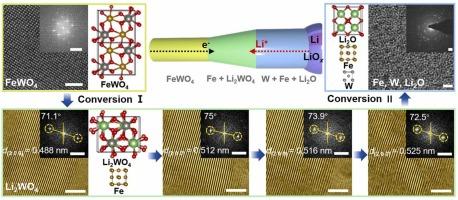原位透射电镜研究锂化过程中FeWO4阳极的转化反应途径和动力学
IF 17.1
1区 材料科学
Q1 CHEMISTRY, PHYSICAL
引用次数: 0
摘要
过渡金属钨酸盐(TMTs)由于其优越的体积容量、良好的电子输运性能和稳定的电化学循环,在锂离子电池(LIBs)阳极研究中越来越受到关注。然而,由于缺乏直接证据,tmt锂化过程中的基本相演化途径在很大程度上仍然不明确。本文战略性地选择钨酸亚铁(FeWO4)作为TMT阳极材料,研究锂化过程中的时间分辨结构演变和反应动力学。通过原位透射电子显微镜(TEM)和同步电子衍射(ED)观察,明确揭示了FeWO4锂化过程中未被探索的两步转化反应机理。令人印象深刻的是,单晶Li2WO4通过原位点阵分辨率成像和密度泛函数理论(DFT)计算被确定为中间相。进一步插入Li+后,Li2WO4的晶格间距随着有序晶格条纹的畸变和破裂逐渐扩大,最终Li2WO4完全转化为Fe、W和Li2O相。最终的分解产物可以回收到FeWO4相,因此可以循环保持可逆的相变反应。原位TEM观测不仅揭示了FeWO4阳极的整个锂化过程,更重要的是为理解其他TMT阳极的锂存储机制建立了一个大体的机制框架。本文章由计算机程序翻译,如有差异,请以英文原文为准。

Unraveling the Conversion Reaction Pathways and Kinetics of FeWO4 Anode during Lithiation via In Situ Transmission Electron Microscopy
Transition metal tungstates (TMTs) are gaining attraction in lithium-ion batteries (LIBs) anode research, primarily attributed to their superior volumetric capacity, good electronic transport property, and stable electrochemical cycling. However, the fundamental phase evolution pathways during lithiation of TMTs largely remain ambiguous owing to the lack of direct evidence. Herein, ferrous tungstate (FeWO4) is strategically selected as a characteristic TMT anode material to investigate the time-resolved structural evolution and reaction kinetics during lithiation. Previously unexplored two-step conversion reaction mechanism during the lithiation of FeWO4 is explicitly revealed by coupling in situ transmission electron microscopy (TEM) with synchronized electron diffraction (ED) observation. Impressively, the single-crystal Li2WO4 is identified as the intermediate phase by in situ lattice-resolution imaging and density functional theory (DFT) calculation. Upon further Li+ intercalation, the lattice spacing of Li2WO4 progressively expands along with distortion and cracking of ordered lattice fringes, ultimately resulting in full conversion of Li2WO4 into Fe, W and Li2O phases. The final delithiation products can be recovered to the FeWO4 phase and therefore reversible phase conversion reactions can be maintained with cycling. The in situ TEM observations not only decipher the whole lithiation process of the FeWO4 anode, but more importantly establishes a general mechanistic framework for understanding the Li storage mechanism of other TMT anodes.
求助全文
通过发布文献求助,成功后即可免费获取论文全文。
去求助
来源期刊

Nano Energy
CHEMISTRY, PHYSICAL-NANOSCIENCE & NANOTECHNOLOGY
CiteScore
30.30
自引率
7.40%
发文量
1207
审稿时长
23 days
期刊介绍:
Nano Energy is a multidisciplinary, rapid-publication forum of original peer-reviewed contributions on the science and engineering of nanomaterials and nanodevices used in all forms of energy harvesting, conversion, storage, utilization and policy. Through its mixture of articles, reviews, communications, research news, and information on key developments, Nano Energy provides a comprehensive coverage of this exciting and dynamic field which joins nanoscience and nanotechnology with energy science. The journal is relevant to all those who are interested in nanomaterials solutions to the energy problem.
Nano Energy publishes original experimental and theoretical research on all aspects of energy-related research which utilizes nanomaterials and nanotechnology. Manuscripts of four types are considered: review articles which inform readers of the latest research and advances in energy science; rapid communications which feature exciting research breakthroughs in the field; full-length articles which report comprehensive research developments; and news and opinions which comment on topical issues or express views on the developments in related fields.
 求助内容:
求助内容: 应助结果提醒方式:
应助结果提醒方式:


